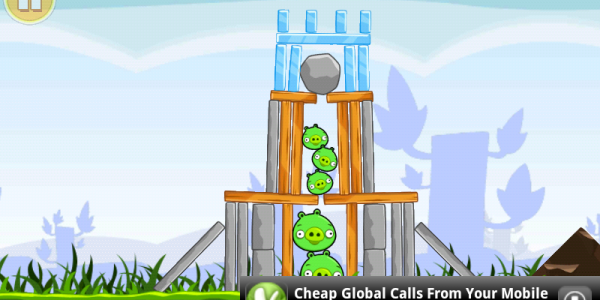Nobody likes a sell-out. Integrity has rarely been an issue for game developers who, by and large, are dedicated enough to their craft that they wish to uphold their artistic merit in favor of placating their corporate masters. It’s a generalization, of course, but most game developers work for the love of the medium rather than to pad their pocketbooks. The hope is that they can achieve both by making the game they want that sells millions of copies. In-game advertising may just be the key.
Just look at the success of Angry Birds, the quirky, addicting, physics-based mobile gaming sensation of 2010: Over 30 million total downloads. The iOS version launched in late 2009 and now has 12 million users who all bought the cartoony hit for 99 cents. The Android version has 7 million users and launched three months ago at a price of zero dollars and zero cents. How? In-game advertising, which nets the game’s developer, Rovio, a reported $1 million dollars a month.
The iOS version of Angry Birds, then, has made significantly more money than the Android version at this time. However, if the ad revenue levels continue for the next two years then the Android version will double the iOS version in revenue, assuming sales on both platforms remain consistent. In-game advertising has enormous potential to drive long-term revenue growth for developers, especially with Rovio’s model, which uses frequent software updates to cycle through different advertisers and increase the revenue. Check out an interview with Peter Vesterbacka for more information on Angry Birds straight from the horse’s mouth.
What does this success story mean for gaming? Maybe nothing. Developers of AAA titles frequently experience fantastic sales numbers, which coupled with the already expensive prices for console games can lead to high revenue levels. But smaller indie developers won’t necessarily receive that kind of monetary success, at least at first, and may turn to other reliable sources of income to fuel their business. In-game advertising has a pretty good chance of being that source.
If in-game advertisements are picked up by an indie developer of, say, XBL titles, then they can sell the game for lss money. A less expensive game is, after all, more likely to sell, and if gamers aren’t too peeved by the occasional pop-up, in-game billboard, or audio plug, then the revenue lost from sales will easily be made up over time.

This trend could even spread to the entire industry, and in fact it probably will. Imagine The Last Guardian peppered with “More Ovaltine, please!” and the occasional “Do the Dew!” Games like Metal Gear Solid: Peace Walker have already made use of similar advertising objects, and the effect is almost universally jarring. Real-world advertisements in a game world take the player out of the experience if improperly included — bad news for gamers, but maybe good news for developers.
At this point, with the proven success of a game like Angry Birds, it seems inevitable that in-game advertising will not only affect but possibly transform the face of the gaming industry. Maybe developers end up dropping the price for games in exchange for a commercial or two. Maybe they keep the prices high and just rake in the dough so their next title has an even higher budget. Maybe it’s not worth the money. Let’s hope for the latter.


















